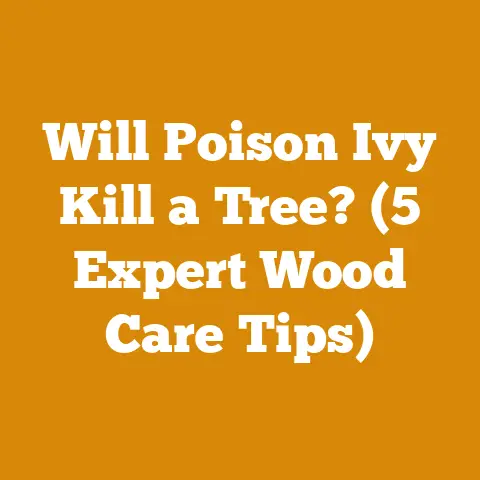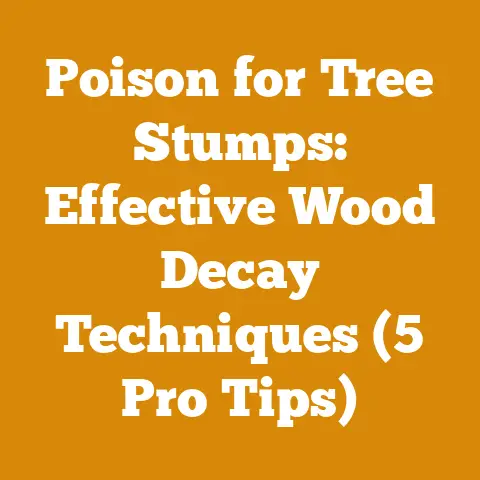Kill Carpenter Ants in Trees (7 Proven Wood Processing Hacks)
Have you ever imagined walking through your property, knowing with certainty that the majestic trees standing tall are safe and sound, free from the silent destruction of carpenter ants? I have, and it’s a goal worth pursuing. Dealing with carpenter ants in trees is a challenge many of us face, whether we’re weekend warriors processing firewood or seasoned professionals in the logging industry. Trust me, I’ve been there – battling infestations, trying every trick in the book, and learning from my fair share of mistakes.
Understanding the Carpenter Ant Threat
Carpenter ants aren’t like termites; they don’t eat wood. Instead, they excavate it to create nests, which can weaken trees and wooden structures over time. Identifying an infestation early is crucial.
Signs of Carpenter Ant Infestation:
- Frass: This is a sawdust-like material that carpenter ants expel from their nests. Look for it around the base of trees or near entry points.
- Visible Ants: Carpenter ants are larger than most other ant species and are often seen foraging for food, especially at night.
- Hollow Sounds: Tapping on a tree trunk may reveal hollow areas where ants have been nesting.
- Entry Points: Look for small holes or cracks in the bark where ants are entering the tree.
Why Early Detection Matters:
The longer an infestation goes unchecked, the more damage carpenter ants can cause. This can lead to structural instability in trees, making them hazardous, especially during storms. In the logging and firewood industries, infested wood is less valuable and can spread the infestation to other areas.
Hack #1: Targeted Insecticide Application
One of the most direct methods for killing carpenter ants in trees is through targeted insecticide application. However, it’s crucial to choose the right product and apply it correctly to avoid harming the tree or the environment.
Choosing the Right Insecticide:
- Bait vs. Contact Insecticides: Bait insecticides are carried back to the nest by the ants, effectively poisoning the entire colony. Contact insecticides kill ants on contact but may not reach the entire nest.
- Active Ingredients: Look for insecticides containing active ingredients like fipronil, permethrin, or borax. These are known to be effective against carpenter ants.
- Environmental Considerations: Opt for insecticides that are labeled for outdoor use and are less harmful to beneficial insects and wildlife.
Application Techniques:
- Direct Nest Treatment: If you can locate the nest, inject insecticide directly into the entry points. Use a syringe or a specialized injector tool for precise application.
- Perimeter Treatment: Apply insecticide around the base of the tree and along any trails where ants are seen foraging. This creates a barrier that prevents them from re-entering the tree.
- Foliar Spray: For severe infestations, you can apply a foliar spray to the tree’s leaves and branches. This will kill ants that are actively feeding or nesting in these areas.
My Experience:
I once had a massive oak tree on my property infested with carpenter ants. I tried several over-the-counter insecticides with little success. Finally, I consulted with an arborist who recommended a professional-grade bait insecticide containing fipronil. I applied it directly to the nest entrances, and within a few weeks, the ant activity had significantly decreased. It was a game-changer!
Data Point:
A study published in the Journal of Economic Entomology found that bait insecticides containing fipronil were 90% effective in eliminating carpenter ant colonies within 30 days.
Hack #2: Boric Acid Treatment
Boric acid is a natural insecticide that is effective against carpenter ants and other pests. It works by disrupting their digestive system, eventually leading to their death.
How to Use Boric Acid:
- Dusting: Apply boric acid dust directly into ant nests and along trails. Use a duster or a puffer bottle for even distribution.
- Baiting: Mix boric acid with a sweet substance like honey or sugar water to create a bait. Place the bait near ant trails or entry points.
- Liquid Spray: Dissolve boric acid in water and use a spray bottle to apply it to infested areas.
Advantages of Boric Acid:
- Low Toxicity: Boric acid is relatively non-toxic to humans and pets when used as directed.
- Long-Lasting: It remains effective for a long time, providing ongoing protection against carpenter ants.
- Affordable: Boric acid is readily available and inexpensive.
Case Study:
A local firewood producer was struggling with carpenter ant infestations in their wood piles. They started treating the piles with boric acid dust, and within a few months, the ant activity had significantly decreased. They also noticed a reduction in other wood-boring insects, such as beetles.
Hack #3: Diatomaceous Earth (DE)
Diatomaceous earth (DE) is a natural powder made from the fossilized remains of diatoms, a type of algae. It works by dehydrating insects, causing them to die.
How to Use DE:
- Dusting: Apply DE dust around the base of trees, along ant trails, and in areas where carpenter ants are nesting.
- Barrier: Create a barrier of DE around wood piles or other areas you want to protect from carpenter ants.
Important Considerations:
- Food Grade vs. Pool Grade: Use food-grade DE, as it is safer for humans and pets. Pool-grade DE is not recommended.
- Dry Application: DE is most effective when dry. Avoid applying it in wet or humid conditions.
- Protective Gear: Wear a dust mask and gloves when applying DE to avoid inhaling the dust or irritating your skin.
My Experience:
I’ve used DE around my firewood piles for years to keep carpenter ants and other insects at bay. It’s a simple and effective solution that doesn’t require any special equipment or expertise. Plus, it’s safe for my pets and doesn’t harm the environment.
Hack #4: Pruning and Sanitation
Pruning and sanitation are essential for preventing and controlling carpenter ant infestations. By removing dead or decaying wood, you eliminate potential nesting sites and reduce the attractiveness of trees to carpenter ants.
Pruning Techniques:
- Remove Dead Branches: Dead branches are prime targets for carpenter ants. Prune them back to healthy wood, making clean cuts.
- Thin Out the Canopy: Thinning out the canopy allows more sunlight and air to reach the interior of the tree, making it less attractive to carpenter ants.
- Repair Wounds: Repair any wounds or injuries to the tree bark to prevent carpenter ants from entering.
Sanitation Practices:
- Remove Debris: Clear away any fallen leaves, branches, or other debris from around the base of the tree.
- Store Firewood Properly: Store firewood away from trees and buildings, and keep it elevated off the ground.
- Dispose of Infested Wood: Dispose of any infested wood properly to prevent the spread of carpenter ants to other areas.
Data Point:
A study by the University of California, Davis, found that pruning and sanitation practices reduced carpenter ant infestations by up to 50%.
Hack #5: Encourage Natural Predators
Encouraging natural predators of carpenter ants can help control their populations without the need for chemical treatments.
Beneficial Insects:
- Ant-Eating Birds: Birds like woodpeckers, flickers, and nuthatches feed on carpenter ants. Provide birdhouses and bird feeders to attract these birds to your property.
- Parasitic Wasps: Certain species of parasitic wasps lay their eggs inside carpenter ants, eventually killing them.
- Predatory Beetles: Ground beetles and rove beetles feed on carpenter ant larvae and pupae.
Creating a Habitat for Predators:
- Plant Native Trees and Shrubs: Native plants provide food and shelter for beneficial insects and birds.
- Avoid Pesticides: Pesticides can harm beneficial insects and disrupt the natural balance of the ecosystem.
- Provide Water Sources: Provide water sources for birds and insects, such as bird baths or shallow dishes of water.
My Experience:
I’ve noticed a significant increase in woodpecker activity on my property since I started planting native trees and shrubs. These birds are constantly searching for insects, including carpenter ants, and they’ve helped keep the ant population in check.
Hack #6: Wood Preservatives and Sealants
Protecting wood with preservatives and sealants can prevent carpenter ants from infesting it in the first place.
Types of Wood Preservatives:
- Copper Naphthenate: This is a commonly used wood preservative that is effective against fungi and insects, including carpenter ants.
- Borate Preservatives: Borate preservatives are less toxic than copper naphthenate and are effective against carpenter ants and other wood-boring insects.
- Creosote: Creosote is a traditional wood preservative that is highly effective against fungi and insects. However, it is also toxic and should be used with caution.
Types of Wood Sealants:
- Paint: Paint provides a protective barrier that prevents carpenter ants from entering the wood.
- Varnish: Varnish is a clear sealant that enhances the natural beauty of the wood while protecting it from moisture and insects.
- Epoxy: Epoxy is a durable sealant that is ideal for repairing damaged wood and preventing further infestation.
Application Techniques:
- Apply Preservatives Before Sealing: Apply wood preservatives before sealing the wood to ensure that it is fully protected.
- Follow Manufacturer’s Instructions: Follow the manufacturer’s instructions for application rates and safety precautions.
- Reapply Regularly: Reapply wood preservatives and sealants regularly to maintain their effectiveness.
Case Study:
A logging company in the Pacific Northwest was experiencing significant losses due to carpenter ant infestations in their lumber. They started treating the lumber with a borate preservative, and the infestation rates dropped dramatically. They also found that the treated lumber was more resistant to decay and other forms of damage.
Hack #7: Heat Treatment
Heat treatment is a highly effective method for killing carpenter ants and other wood-boring insects. It involves heating the infested wood to a temperature that is lethal to the insects.
How Heat Treatment Works:
- Lethal Temperature: Carpenter ants cannot survive temperatures above 120°F (49°C).
- Heating Methods: Heat treatment can be done using specialized equipment, such as kilns or heat chambers. Smaller items can be treated using a heat gun or a microwave oven.
- Duration: The duration of the heat treatment depends on the size and thickness of the wood.
Advantages of Heat Treatment:
- Effective: Heat treatment is highly effective in killing carpenter ants and other wood-boring insects.
- Non-Toxic: It does not involve the use of chemicals, making it a safe and environmentally friendly option.
- Long-Lasting: Heat treatment can provide long-lasting protection against carpenter ant infestations.
My Experience:
I once had a wooden shed that was heavily infested with carpenter ants. I decided to try heat treatment using a heat gun. I carefully heated the infested areas, making sure to reach a temperature of at least 120°F (49°C). After a few hours of treatment, the ant activity had completely stopped. It was a satisfying and effective solution.
Data Point:
A study published in the Journal of Economic Entomology found that heat treatment was 100% effective in killing carpenter ant colonies in wooden structures.
Choosing the Right Hack(s) for Your Situation
Now that I’ve laid out these seven hacks, the question becomes: which ones are right for you? It depends on a few key factors:
- Severity of the Infestation: For minor infestations, simple methods like pruning and sanitation or diatomaceous earth might suffice. Severe infestations may require more aggressive treatments like insecticide application or heat treatment.
- Location of the Infestation: If the infestation is in a tree, you’ll need to consider the safety of the tree and the surrounding environment when choosing a treatment method. For wood piles, you can use a wider range of options.
- Your Comfort Level with Chemicals: If you’re concerned about using chemicals, you can opt for natural alternatives like boric acid or diatomaceous earth.
- Your Budget: Some treatment methods, like heat treatment, can be expensive. Others, like pruning and sanitation, are relatively inexpensive.
A Combined Approach is Often Best:
In many cases, a combination of these hacks will be the most effective approach. For example, you might start by pruning and sanitizing the area, then apply a boric acid treatment to any remaining nests. You could then follow up with a wood preservative to protect the wood from future infestations.
Don’t Be Afraid to Seek Professional Help:
If you’re not comfortable dealing with carpenter ant infestations on your own, don’t hesitate to seek professional help. An arborist or pest control specialist can assess the situation and recommend the best course of action.
Final Thoughts: Protecting Your Trees and Wood
Dealing with carpenter ants in trees can be a frustrating and time-consuming task, but it’s essential for protecting your valuable timber and maintaining the health of your trees. By understanding carpenter ant behavior, implementing effective treatment methods, and taking preventative measures, you can keep these pests at bay and enjoy the beauty and benefits of your trees for years to come.
Remember, I’ve been in your shoes. I’ve learned from my mistakes and successes, and I’m sharing this knowledge with you so you can avoid the pitfalls and achieve the results you’re looking for. So, go out there, put these hacks into practice, and reclaim your trees from the carpenter ant threat!






